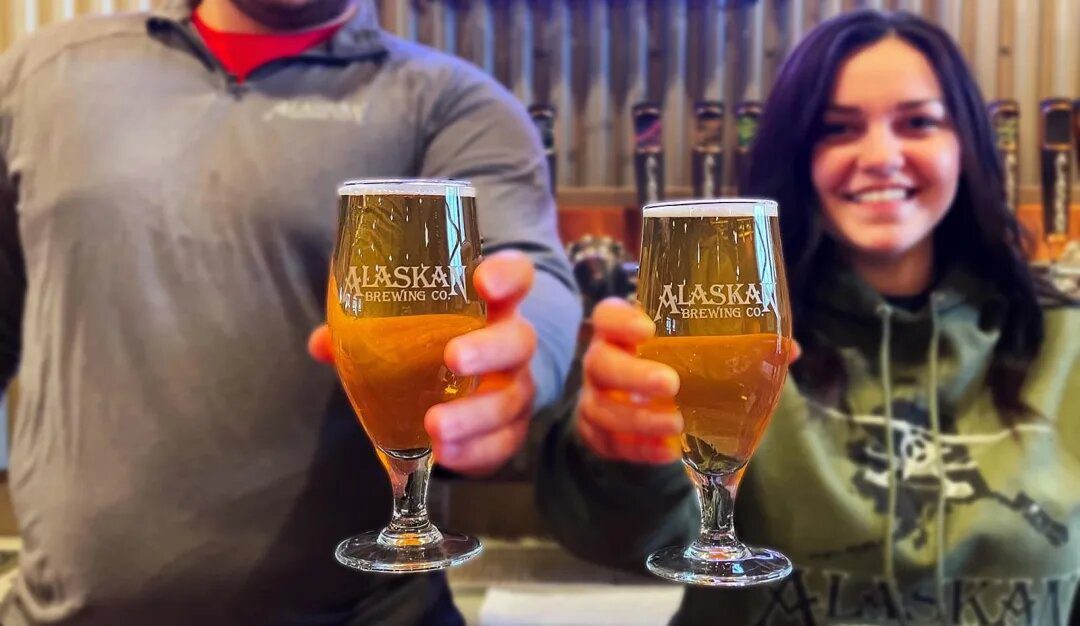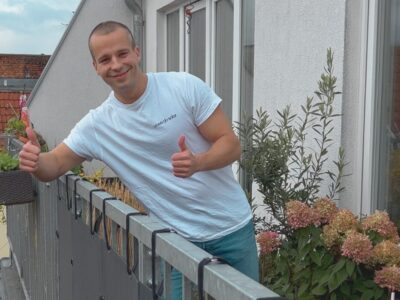ICYMI, our wildest Made In America Glass Half Full episode, takes place on the last frontier. Marcy and Geoff Larson, the married co-founders of Alaskan Brewing Company, have built an impressive collection of beer that reflects the exciting and rugged character of the Last Frontier. They came to Juneau, Alaska, in 1986 with limited brewing and business experience. Today, they run one of the premier American craft breweries known globally for emphasizing technological innovation and sustainability.
While we love learning business lessons from our favorite product sectors, delving deep into Alaskan Brewing’s rise to prominence and how the co-founders built strategies to overcome the most daunting circumstances is inspiring to all business minds and entrepreneurs. Marcy and Geoff have transformed a long list of challenges (i.e., brutal geography, relative industry inexperience, and a dormant local culture for their product) into strengths that helped them revolutionize the brewing industry. Here are three critical lessons from their story that have influenced my current outlook on business and merit closer study:
Innovate by Embracing Challenges
We see it repeatedly in business: adversity is an opportunity to create a better product. When presented with difficult circumstances, urgency can help us build. In these “sink or swim situations,” people either rise to the occasion or crumble under pressure. Achieving the former result is predicated on innovating. Simply adhering to established techniques (i.e., taking the easy route) is not enough to stay afloat financially. This requirement to reinvent is incredibly challenging; however, hyper-focusing on the negatives is a recipe for disaster. The secret to overcoming these difficulties is developing a growth mindset. This way of thinking requires embracing potential roadblocks and recognizing that through struggle, we find resolutions. If one just changes that perception, “constraints” are not that constraining. They are creatively freeing and a force to develop a novel, better solution. One of the most significant guarantors of this pressure to innovate is geography. Sometimes, the most unlikely locations give birth to the next great idea.
Alaskan Brewing Company – based in Juneau – is effectively separated from mainland North America. How do you build a local brewery when supplies must be imported by sea or very expensively (and slowly) across the tundra? Alaskan sought opportunities to reinvent the brewing process. To understand this challenge’s extent, Juneau has the 19th highest cost of living among American cities, with grocery prices being 28% higher than the national average. Diesel is also widely used to power businesses. This factor magnifies these financial stresses because Juneau experienced its highest-ever recorded average diesel price last November (i.e., an astounding $6.24 per gallon).
Overcoming all of these factors is a daunting task, but Alaskan innovators have embraced the struggle and are developing sustainable methods to turn a profit. Marcy and Geoff have redesigned the brewing process to this effect. To reduce the total cost of its component parts, Alaskan Brewing became the first company in the craft beer industry to employ CO2 capture and recycling technology, which reuses the carbon byproduct of the brewing process to help repackage new batches of beer. This decision freed them from dealing with the high cost of importing CO2 from the lower 48 while also helping them prevent millions of tons of GHG emissions. They also employ a mashed filter press that requires 6% less input grain while saving 2 million gallons of water annually. To lower waste removal and fuel costs, Marcy and Geoff pioneered the “Beer Powered Beer” system that uses a biomass boiler to burn excess brewing grain as fuel, which has helped them reduce their diesel consumption by 65,000 gallons a year. This saves the business while significantly mitigating the firm’s carbon emissions. All these cost-saving measures have allowed Alaskan Brewing to endure and thrive economically, and emphasizing sustainable practices was also a primary factor in their financial success. This fact has caused brewers worldwide to notice and adopt these environmentally-conscious technologies.
Marcy and Geoff are exceptional business people who would have innovated in any environment, but let’s not downplay the fascinating influence of constraints in their situation. As Geoff said, If [success] was easy, we’d go the easy route.” The presence of tough challenges prompted Alaskan Brewing to think more creatively to survive. Reflecting on this story, we can think about Marcy and Geoff’s success as a metaphor for innovation during the climate crisis. We know the stakes are high as we are faced with an urgency to improve the planet’s health. Luckily, this pressure is already spurring an area of great technological discovery. I know we are on the precipice of implementing sustainable practices that will keep our planet healthy forever.
Catalyze Growth By Leaning on Your Local Support Network
When someone has a revolutionary idea, there is a tendency to believe that it is necessary to court prominent venture capitalists to scale and fund R&D. While this can be a great way to grow rapidly, it is not the only path to success. Building a portfolio of smaller investors can be just as effective. Nowadays, finding this source of financial backing has been made much easier due to the power of crowdfunding online. For example, the VR giant Oculus Rift gathered $2.5 million in funding from the general public on Kickstarter. This capital helped the company create more impressive prototypes, eventually convincing Meta (then Facebook) to buy Oculus for around $2 billion. However, this digital strategy is a recent invention. Before the age of the internet, intrepid small business owners had to rely on funding from a more specialized demographic: their surrounding communities. These groups may lack size, but their passion for hometown products is undeniable. If an entrepreneur can articulate a localized aspect of their vision, the surrounding community will become extremely excited about the potentially transformative benefits of the product. It could become its most loyal segment of investors. In today’s interconnected world, we often overlook the awe-inspiring power of regionalized unity and the symbiotic relationship between fledgling startups and their local environment.
Alaskan Brewing’s humble origins provide evidence for these insights. Marcy and Geoff had limited business and brewing experience when they conceived of developing a unique Alaskan-style beer. As such, more prominent investors were not willing to take a risk on such an unproven leadership team. However, the couple’s love for Alaska and intense desire to give back to the state more than compensated for their lack of formal training. The couple recently revealed that the company’s business statement included the core pillar of “keep[ing] the economy, people, and environment…healthy, wealthy, and alive.” The surrounding community recognized and identified with the fledgling firm’s ambitious mission. They also realized that a premier craft brewing company could create a tremendous economic impact on the state while adding a unique aspect to the region’s culture. With these considerations in mind, 88 representative members of the larger community joined together to aggregate their smaller-scale investments to fund the project.
Fast forward to today, and Alaskan Brewing has proven that they deserved this vote of confidence as they support their community in many ways. The main area of impact relates to improving the general quality of life in the state. Marcy and Geoff have stimulated the local economy by building a successful brewing business that captures roughly $29.4M in revenue annually. Much of this generated capital is reinvested into the state’s well-being. For example, the firm is directly elevating its team members’ level of wealth through an employee stock ownership program. More broadly, Alaskan Brewing donates 1% of its IPA’s gross proceeds to watershed cleanup charities. This philanthropic focus is essential because massive plastic inflows across the Pacific plague Alaska’s beaches. The firm’s constant commitment to the health of these aquatic ecosystems protects the state’s natural resources while allowing citizens to enjoy a cleaner environment.
If you only remember one aspect of this story, community outreach must be a key aspect at the inception of any startup. Entrepreneurs should be incredibly motivated to connect with their local environment to generate a foundational level of funding and buzz, boosting their chances of attracting large investors later in the scaling process. In many cases, these companies are shaped by their surrounding community, and, as such, they have a duty to give back to those who helped make their success a reality.
Create by Becoming a Student of History
Creativity is not about generating the next great idea out of thin air. All progress is cumulative, and innovators always rest on the shoulders of past giants. More specifically, every type of creator must develop a comprehensive understanding of their particular industry’s existing knowledge base to achieve progress. However, this learned expertise should not merely be used for replication, which alone cannot drive creative advancement. Quentin Tarantino himself echoes a similar sentiment as he once explained, “Great artists steal. They don’t do homages.” Stealing does not refer to copying others but rather to harnessing historical techniques as an essential tool for creating entirely new artistic products.
Alaskan Brewing Company’s ideation process is influenced by past traditions. Over the years, Marcy and Geoff have acquired a deep knowledge of brewing history, specializing in Alaskan beer. This is especially significant to their company because they set out to create an artistic product (i.e., beer) representing their region’s local character. To realize this lofty goal, Alaskan Brewing approaches the creative process like a research project. For example, when they were developing their flagship product (i.e., the Alaskan Amber), Marcy and Geoff sought to reengineer the first truly Alaskan beer, which was popularized during the Gold Rush but had since gone extinct. They did this by studying 100-year-old invoices from one of the state’s original breweries: Douglas City Brewing Company. This fact-finding mission helped them gather the right materials (i.e., ale yeast, dark malts, and Bohemian Hops) to input into the modern brewing process. The result was a uniquely Alaskan beverage that respected the state’s cultural tradition while providing something novel to the state’s beer scene.
Interestingly, the company involves all its employees in this creative process. The brewers, accounting staff, and sales team come together in diverse groups to brainstorm and research. Some of the most significant results of their collaboration include the spruce tip-infused Winter Ale (a new spin on a recipe from the Age of Exploration) and the award-winning Smoked Porter, which invokes the smoky characteristics of the traditional alder smokehouse. In these cases, Alaskan Brewing is inspired by the past but is not beholden to it. They use these historical influences to build upon their industry’s existing knowledge base before pushing past the boundaries of convention through artistic innovation. Their example is one that I think many creatives could benefit from, and I am always thrilled when great minds continue to build upon humanity’s rich cultural and technological traditions.





